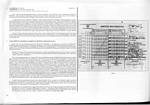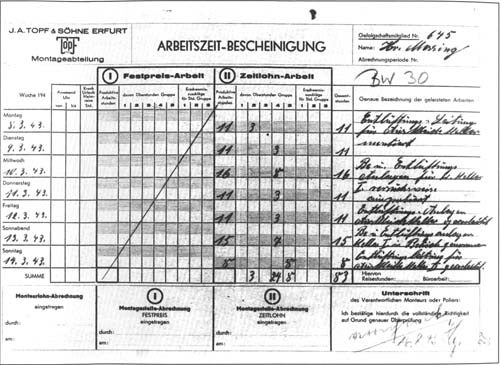|
|
 |
 |
AUSCHWITZ:
Technique
and Operation
of
the Gas Chambers © | |
|
| |
 |
Back |
 |
Contents |
Page 434 |
 |
Home
Page |
Forward |
 |
| |
| 5. |
Auskleidekeller [4
mentions]
Auskleidekeller II [1 mention] / undressing
cellar
[PMO file BW 30/41, pages 25, 26 and 28, dated 8th to
14th March and 22nd to 31st March 1943] |
[Photos 5, 6,
7] |
| |
|
|
| |
These
“Arbeitszeit-Bescheinigungen / timesheets” concern the installation
of the ventilation systems of Krematorien II and III by MESSING, a
fitter employed by Topf & Sons of Erfurt, between 5th January
and 9th June 1943. [This “diary” of the installation is reproduced
in full and translated in Part II Chapter 6 “The ventilation systems
of Krematorien II and III”]
A civilian employed
by an outside firm worked for six months in Birkenau Krematorien II
and III, in their Leichenkeller l, Leichenkeller 2 and Ofenraum, or
in other words in the gas chambers, undressing rooms and furnace
rooms. The term “Auskleidekeller” to designate Leichenkeller 2
appears in the week 5th to 14th March. Working on the ventilation of
the “underground morgue”, it seems very surprising that, two months
after his arrival in Birkenau, he should be calling them “undressing
cellars”. Although we have no proof of this, it seems practically
certain that Messing filled in his work sheets at the end of each
week. As the first homicidal gassing took place in the evening of
Sunday 14th March, and as Messing had been working all day in
Leichenkeller 2, which was not yet used as an undressing room (the
victims undressed in a hut temporarily erected in the north yard of
Krematoriunn II), it is obvious that, though he did not witness this
gassing. certain preparations and stories going around were
difficult to hide so that Messing was led to give Leichenkeller 2
the name of its true function. Unfortunately, he did not have the
courage, or perhaps the desire or the occasion to write that
Leichenkeller 1 was a gas chamber.
The entry for 8th to 14th
March cannot be contested. The work site is indicated, BW 30 (or
Krematorium II) and the room where he was working, cellar II is
localised and referred to as “undressing” cellar. In the other
entries, the word “Auskleidekeller”. even without the “II” aways
refers directly to the same room and these mentions constitute so
much additional evidence that Leichenkeller 2 had become an
undressing room. |
| |
|
|
| 6. |
Gastür 100/192 für
Leichenkeller 1 / gas[tight] door 100x192
for underground
morgue 1: |
|
| |
|
|
| |
“... Auftrag vom
6.3.43 über Lieferung einer Gastür 100/192 für Leichenkeller 1 ...
die ganau nach Art und Mass der Kellertür des gegenüberliegenden
Krematorium II mit Guckloch aus doppelten 8 - mm - Glas mit
Gummidichtung und Beschlag auszuführen ist / ...order of 6/3/43
concerning the delivery of a gas[tight] door 100x192 for underground
morgue 1 ... to be produced to the identical pattern and dimensions
as the cellar door of Krematorium II situated opposite [to
Krematorium III] with peephole of double 8 mm glass, with rubber
sealing strip and frame" |
| |
|
| |
[File BW 30/34, pages 49 (first original with “Türme /
towers”) and 50 (second original with one of the two “Türme”
corrected to “Türen / doors”). Annex 3 of volume 11 of the Hoess
trial (copy authenticated by the Polish examining judge Jan Sehn
with the two “Türme” replaced by “Türen / doors” )]
|
| |
|
| |
The second paragraph
of a letter of 3Ist March 1943 by Kirschneck [Photo 8],
signed by SS Major Bischoff and initialed by its author, speaks of
an order of 6th March 1943 for a gas[tight] door, 100 cm wide by 192
cm high, destined for Leichenkeller I of Krematorium III to be
constructed exactly like the cellar door [Leichenkeller 1] of
Krematorium II. This is a vital paragraph as regards Krematorien II
and III since it indicates that their Leichenkeller I were each
fitted with “gas doors” with a rubberized sealing strip and
inspection peephole, a type of door used in the disinfestation gas
chambers. Considered until 1979-50 as a document which, associated
with “Vergasungskeller”, proved the existence of homicidal gas
chambers in Krematorien II and III, it now remains a highly
compromising piece of evidence, but no more than that. If we assume
that Leichenkeller 1 are disinfestation gas chambers, fitting them
with “Gastür” is normal and logical. On the other hand, they can no
longer be called “typical morgues”. Although the revisionists,
pulling out all the stops. first claimed that morgues had to have
such doors to contain the smell and infectious germs, then in
response to toxicological analyses carried out on the upper
ventilation hole covers that showed the presence of cyanides,
explained that this was no cause for concern. because these “typical
morgues” with gas-tight doors were disinfected using Zyklon-B (an
INSECTICIDE!), the fact remains that Drawing 932 showing the
Krematorium II basement formally shows that the underground rooms
were designated “Leichenkeller / corpse cellars” [or
morgues], access to which was through DOUBLE DOORS, 190/190,
not a single door 100/192. The morgues were converted into
gas chambers. and there are documents to prove it, but this
modification should be perfectly acceptable to the revisionists.
since their version of “disinfected [with Zyklon-B!] morgues” still
remains valid. It simply remains for them to integrate in their
“explanation” the presence of “14 Brausen / 14 [DUMMY] showers” in
the “disinfected morgue” of Krematorium III.
This
letter reveals the astonishing concordance between the order dates
for “Gas-” components. On 5th March. a handle was ordered for a
“Gastür” in Krematorium II, a door that must have already [been]
installed. On the 6th, there was an order for another “Gastür” for
Krematorium III and mention in an other letter of an “undressing
room”, probably in Krematorium II. On the 14th a week later, a group
of 1500 Cracow Jews inaugurated the “Vergasungskeller (1 )” of
Krematorium II. |
| |
|
| |
[Additional note: It
is regretable [hat the original of the “Schlosserei WL” file can no
longer be consulted at the PMO Archives, for the making of a
“Gastür” for Krematorium III should be recorded in it. The
mention of that of Krematorium II is more doubtful, because since
the first order in the file is dated 5th February 1943, it is
possible that the door was made earlier than that. Second. it is
certain that the sealing strips of the “Gastüre”, planned to be of
rubber, were actually made of felt.] |
|
 |
Photo
5 | |
| |
AUSCHWITZ:
Technique
and operation
of the gas chambers
Jean-Claude Pressac
© 1989, The
Beate Klarsfeld Foundation |
 |
Back |
Page 434 |
Forward |
 |
|

